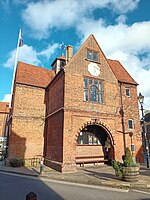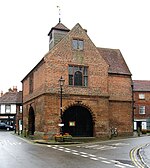Shirburn Castle is a Grade I listed, moated castle located at the village of Shirburn, near Watlington, Oxfordshire. Originally constructed in the fourteenth century, it was renovated and remodelled in the Georgian era by Thomas Parker, the first Earl of Macclesfield who made it his family seat, and altered further in the early nineteenth century. The Earls of Macclesfield remained in residence until 2004, and the castle is still (2022) owned by the Macclesfield family company. It formerly contained an important, early eighteenth century library which, along with valuable paintings, sculptures, and other artifacts including furniture, remained in the ownership of the 9th Earl and were largely dispersed at auction following his departure from the property; notable among these items were George Stubbs's 1768 painting "Brood Mares and Foals", a record setter for the artist at auction in 2010, the Macclesfield Psalter, numerous rare and valuable books, and personal correspondence of Sir Isaac Newton.
On account of its "fairy tale" external appearance and unmodernised interior, the castle has been used on occasion for film and television settings and is possibly best known to the outside world via that route, since it remains in private hands, no roads pass it, and it is generally not open to the public for visiting. In addition, any history of the castle is somewhat obscured by lack of permitted access to scholars of medieval architecture over the past one (to two) hundred years as well as by conflicting statements in available published accounts; these include that the present castle has Norman origins and/or is on the site of a Norman precursor (not supported by any evidence), that the castle is an early example of brick construction (based on a mis-interpretation), and that the castle was badly damaged during the English Civil War prior to its rebuilding in the eighteenth century (no evidence exists for this assertion). A further piece of apparently deliberate misinformation was a claim that "Shirburn Castle" was visited by a tutor of Dante at the end of the thirteenth century, before the present structure was known to exist; the 1802 document upon which this assertion was based was subsequently shown to be a forgery.









